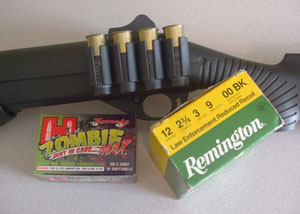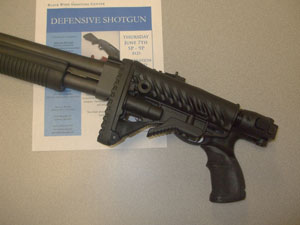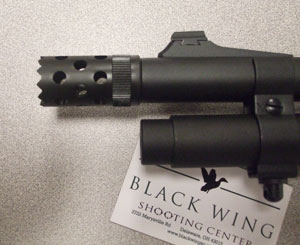Consider the shotgun: traditional provider of meat for the pot, defender of hearth and home, and long regarded as the ultimate in anti-bad-guy ordnance. Having conducted a fair number of shotgun home-defense courses over the years, I've had the opportunity to see a lot of different people, with a lot of different levels of experience, handle a lot of different shotguns. However, a few similarities have emerged over time regarding people and their favorite scattergun. From the 58-year-old insurance adjuster to the 26-year-old police officer to the 33-year-old single mother, I've made the same observations time and time again. So with your kind indulgence, I'd like to look at a few of these items and the ways they can be addressed. After all, fixing things in training mode can help stave off catastrophe in reality mode.
For simplicity's sake, I'll divide the subjects I'm discussing into two categories. In this first part, we’ll look at shotgun accessories, and in a future installment, training with a shotgun.
Let's start with the add-ons. Ten years ago, the shotguns my students were bringing into class were pretty predictable: overwhelmingly, they were pump-action 12-gauge guns and were in pretty much the same configuration as they’d been on the day they left the factory. Today, I see a good number of semi-automatics. A plain unadorned pump gun is a bit of a rarity. It now seems that the variety, availability, and popularity of combat-themed accessories knows no limits. It stands to reason that not every aftermarket option is a good idea, let alone a necessity, on a home-defense gun. Here are some accessories that have demonstrated their value repeatedly.
Adjustable Buttstocks
Because I see lots of civilians looking for home-defense training, I see couples who have but one shotgun between them. In the past, this created some difficulties because the pair of users rarely had the same physical build. Recoil control is a big job with a 12-gauge defense gun, and it's only made harder if the gun is too long for the shooter using it. That's why I'm a big fan of the adjustable stocks available today on any shotgun that might find itself in the hands of more than one member of the household.
Today's adjustable buttstocks are modeled after the simple four- or six-position designs found on the military M-4 carbine and its legion of commercial clones. They’re easy to use and, as an important bonus, several of the better models feature recoil-reduction capability.
The Knoxx/Blackhawk SPEC-OPS was the first widely available such unit and is still the standard by which others are measured. At Black Wing Shooting Center, we've been testing a similar unit made by Advanced Technologies International (ATI) on a rental/training gun and are very pleased with the results. Also, we have worked with a FAB Defense stock, made in Israel, which adds a side-folding option as well. The bottom line on adjustable buttstocks for defensive guns is this: In 2012, there is no reason that anyone needs to use a gun that is too big for their frame. Combine an adjustable buttstock with one of the currently available reduced-recoil defensive ammunition products, and there is no reason that the shotgun can't be a viable means to repel invaders for just about anyone.
On-Board Ammunition Carriers
The home defense shotgun is a unique kind of firearm in any number of ways. If we're looking at a pump-action or semi-automatic shotgun, we see that they have a really interesting capability that our handguns and rifles don't: the ability to be ready to fire (or be fired, for that matter) while we are adding ammunition to the magazine. How cool!
I'm not going to examine and debate the tactical circumstances that put me into such a situation: I'm merely pointing out that I can grab an empty shotgun, drop one round onto the elevator, close the action, and have a gun that will go boom! if I need to press the trigger in defense of myself and my family. And once that round is chambered, if circumstances so permit, I can continue to feed rounds into the magazine while ready to engage a threat. This is where an on-board ammunition carrier makes sense.
Products such as the humble elastic cuff stretched over the stock and with loops to hold four or five rounds of ammo will do. There are pouches of various design and capacity that strap onto a conventional stock with hook-and-loop fasteners. But perhaps the ideal system is the shotgun sidesaddle. Numerous variants exist from numerous makers, but the essential idea is to mount a bracket holding extra shells to the side of the gun's receiver. This system gets the nod because it is generally easier to reach while keeping the gun in anything close to a shooting position. Also, if you recognize the wisdom of a recoil-reducing adjustable buttstock, you don't really have a place for an elastic cuff or strap-on pouch. In any event, an on-board ammunition carrier will make the home defense shotgun, loaded or not, into a true grab-and-go system, ideal in these uncertain times.
Tactical/Breacher Chokes
Obviously, there are numerous other accessories you may consider. These are just the two examples I most commonly advocate to civilian home defenders. And of course there are items that I don't encourage for the homeowner's pump or semi-auto shotgun. In this category, one accessory has become common enough lately to merit discussion: the tactical/breacher choke.
From a home-defense perspective, this just doesn't bring much to the party. First, although I'll admit to not having the statistics close at hand, the need for a defender to breach an obstacle inside his own home has got to be pretty rare. Most military/law enforcement "door breacher" guns have either a muzzle device that has been welded to the gun or no device at all. The narrow threads used on screw-in shotgun choke tubes may not be up to the task.
Second, they add length to a long gun that we may have to manipulate in the confines of an interior hallway or other narrow space. Many of these chokes are topped with some sort of aggressively sharp serrations to better bite and hold doors and walls for proper standoff during breaching operations. They may well do this with any object we bump into while in the midst of a scary situation. A snagging hazard that adds unneeded length is difficult to endorse.
Lastly, tactical/breacher chokes are thought to have some utility as pain-compliance devices or enhancements that improve the shotgun's utility as a striking instrument should it become non-functional in its firearm role for whatever reason. While I would not argue that such a use is impossible, just ask any soldier how often they attach and use their bayonet in combat. For civilian home defenders, I prefer guns that are as short and snag-free as possible when playing "keep away" with a bad guy. In an extreme emergency, striking at the evildoer and then moving away are preferred.
I don't like breacher chokes as blunt-force weapons for the same reason I don't like (ugh!) rubber buckshot as a home-defense load: I don't think it’s a great idea to point a lethal weapon at another human being, operate it as designed, and expect it to produce non-lethal results.
Now, don't think I don't appreciate the cool factor. The fact is, I have bought and own stuff that has no real purpose other than to make me happy. I have no problem with someone having a tactical/breacher choke on their shotgun because they like it. But I caution people not to assign it duties to which it is unsuited. I advise all my students to replace the tactical choke with a flush-fit IC choke during home-defense duty in order to negate the possible disadvantages.
Conclusions
In summary, adjustable recoil-reducing stocks and on-board ammo carriers are good add-ons for your home-defense shotgun. Tactical/breacher chokes are less so. But it is our training and upkeep of the needed skill sets that really make the difference. In Part II, I’ll make some observations on shotgun training considerations for non-armed professionals, casual users, and home defenders.





Use #4 buck shot more pellets than 00. That is what I used while on patrol as San Bernardi Co. Sheriff
Considerations between birds head, pistol, full butt with a pistol grip. Also discuss the 3 round magazine extension over the esthetics of the 3” extension beyond the end of the barrel. Mention the fine Turkish semiautomatic clones that bring the advantages of that platform within reach of the low budget home defender.
I have tried a couple of different "side saddles" on my Rem. 870 shotguns and they interfere with the rearward movement of the slide. Rather than trying to modify the slide, I carry my extra ammo in a butt cuff.
You have some awkwardness for lefties with a side saddle
The only other thing that you're missing is a laser and I know it sounds a little ridiculous on a shotgun but it's not it is extremely accurate and it works extremely well the other thing is a red dot sight Red Dot works well quicker acquisition of the side of the subject it's it's a must have on a shotgun for in home defense now
Semi-auto shotguns have less recoil than pump actions. This is not ZERO recoil; it's just less. The 20 gauge is very effective for smaller- weaker people. You still have to AIM! A recoil reducer (such as a limb saver) is an excellent option!
The one accessory I feel you should have included, especially for home defense, is some sort of mounted flashlight. They are immensely important while searching at night, during a power outage, etc.
I agree, Bobby, that I disagree with the opinion that pump action shotguns are not appropriate for home defense. People of average or even below average size, coordination, and familiarity with firearms have learned manipulation of pump action weapons.
A laser is really nice, go with green because the bad guys don’t always come at night.
The problem with the two sidesaddles I've purchased for my Rem 870 shotgun is that when mounted, they block the slide from full travel. Major modification to the pump handle would be necessary to make them work, yet they were both marked for the 870.